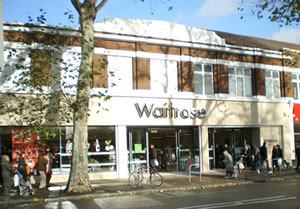Estate Agents Set Little Store By 'Waitrose Effect' in Chiswick
Lloyds Bank report says property prices are high in W4 due to premium supermarkets
|
A new report by Lloyds Bank is claiming that Chiswick property prices are much higher the rest of the borough due to a ‘Waitrose Effect.’ They believe having a premium supermarket in your area means that you will have to pay much higher prices for a home and that there is only one other place in the UK where this effect is stronger than in W4.
The report states that Chiswick has the second biggest property price premium over the surrounding area in the country with home values 89% above those in the borough of Hounslow as a whole. This is attributed the presence of premium supermarkets which the bank says is related to high property prices. Lloyds quotes the average price in Chiswick as £940,218 against £496,207 for the borough. The highest premium in the country is for Ponteland in Newcastle which has a Waitrose, a Sainsbury’s and a Co-Op and prices more than double that in the rest of Newcastle.

The bank’s analysis shows that average house price in an area with a Waitrose store is £429,118 – the most expensive of all the chains - and more than double compared to areas with an Aldi store (£198,810), which is the least expensive. The next most expensive are areas with a Marks and Spencer (£350,263) and Sainsbury’s (£314,154).
Properties in areas with a Waitrose, Marks and Spencer, Sainsbury’s or Iceland are most likely to command a higher house price premium when compared to the wider town average and Chiswick has three out of four. And prices near upmarket supermarket brands can be particularly high. For example, the average price for properties within easy reach of a Waitrose is typically £36,480 higher than the wider town average (£429,118 versus £392,939).
Paul Cooney, Horton and Garton's Chiswick Director, laughs, "It's a fact our buyers do regularly ask how close the property they're viewing is to Waitrose! The statistics from Lloyds make for interesting reading, supporting what most local residents already recognise - the polarisation of our borough. Chiswick represents by far the most affluent area in the London Borough of Hounslow."
However he doesn't believe it is all about big brand chains saying, "Whilst the top tier supermarkets play a part in driving up house prices, I'd be remiss not to mention the many small independent retailers that are a part of the fabric of our community. As a local business owner myself, I recognise and do not underestimate the importance of locally owned and operated establishments like Marie's in Cunnington Street which was threatened with closure only a couple of years ago. Often it isn't until these essential corner shops are under threat that we realise their true value. "
Andrew Wilkins, an Associate at Knight Frank in Chiswick said, “Chiswick is blessed with an number of supermarkets and whilst it’s hard to quantify the precise value added to your home we would certainly agree with these average prices. Interestingly it is the middle band (Sainsbury’s and Tesco) who take the risk of opening up in what could be seen as a growing area whilst Waitrose and M&S tend to launch in established strong affluent markets. “
Andy Mason Lloyds Bank mortgages director, commented, “With homes in areas close to major supermarkets commanding a premium of £22,000, the convenience of doing weekly shopping within easy reach may well be a pull for many homebuyers looking for good access to local amenities. The ‘Waitrose Effect’ is clear; having a premium brand on your doorstep means buyers typically need to pay top prices.”
Andrew Nunn of Andrew Nunn & Associates wasn’t inclined to take the research that seriously and said it reminded him of a Michael Mcintyre sketch for which he helpfully sent us a link to the video below.
However, the gap does appear to be closing with budget supermarkets increasingly being seen as adding to an area’s value. Andy Mason added, “The research also shows that areas with ‘budget’ stores have, on average, seen the most rapid house price growth in recent years.
“There has been some suggestion that the likes of Lidl and Aldi are increasingly locating in more affluent areas where prices are already relatively high. Indeed, in 2014 house prices in areas with a Lidl were, on average, £4,700 lower than in neighbouring areas; today they are £6,400 higher.”
Both Aldi and Lidl have stated their intention to look to open stores in areas with higher average incomes including in London.
June 4, 2017